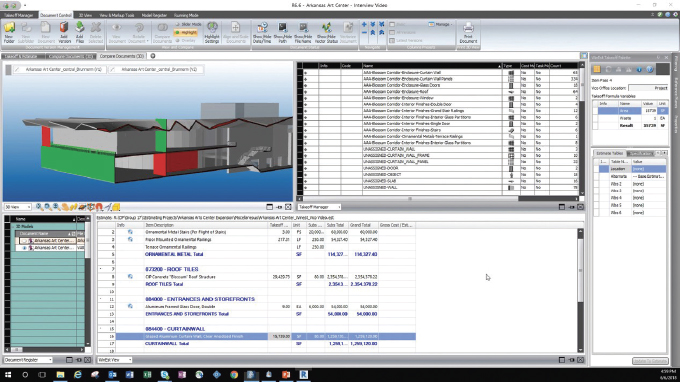the key to more competitive and accurate estimates
For general contractors, estimating is inarguably one of the most important and challenging aspects of any project, especially in today’s market where the pressure is high to deliver competitive estimates in tight time frames. Delivering an estimate that is too high puts contractors at risk of losing the project to a competitor. On the other hand, an estimate that is too low can eat into profits. Needless to say, delivering an estimate that is both competitive and profitable is only possible if the amount of guesswork going into it is limited. To overcome this challenge and deliver more accurate bids faster, a growing number of forward-thinking contractors are taking advantage of technology innovations and digital takeoff.
ACCURATE ESTIMATE
Achieving the most accurate estimate starts with a methodical approach to takeoff. Essentially, takeoff should quantify all the materials needed to complete the project. However, it does not include assets, such as tools and equipment. Instead, the focus should be on the raw materials and associated labor costs needed for the project, such as concrete foundations and flatwork, lumber or steel, prefabricated materials, electrical, plumbing, HVAC, and fixtures. The takeoff should also specify the type of material required, such as the grade of steel or type of electrical cable, and capture count, length, area, and volume.
Today, most contractors are using non-integrated takeoff and estimating tools which requires them to reenter takeoff quantities. By using takeoff tools that are integrated with the estimating tool, the data only needs to be entered once which saves time and reduces the chance of errors.

FIRSTHAND LOOK
A growing number of general contractors are moving to a constructible process where all phases and professions are connected, models and work-streams are content-enabled, and constructible data drives smart workflows. This includes switching from 2D takeoff methods to more visual more productive 3D takeoff methods. This approach is faster, more accurate and makes it easier to collaborate and communicate among all stakeholders.
Pepper Construction: Pepper Construction is one of the largest contractors in the Midwest. After it was awarded preconstruction of a $60 million senior living facility in Illinois, the team began performing on-screen digital takeoffs, generating quantities and then manually entering them into construction estimating software. Without a way to visually confirm that all required items were identified, this conventional 2D on-screen takeoff process was time consuming and tedious. The team wanted the ability to develop granular-level breakouts within estimates to give customers more insight into project costs and was also looking for more consistency in their pricing process.
Pepper adopted an integrated construction management solution spanning 2D, 3D, 4D, and 5D BIM to bring together construction estimating, scheduling, and design management. As a result, their workflow is tightly integrated across a BIM-neutral platform where multiple types of BIM models can be published, synthesized, and augmented with cost and schedule information. Pepper’s estimating software is fully integrated with the company’s quantity takeoff tool which gives the team access to one database of items and assemblies alongside their 3D BIM quantities and 2D electronic plan takeoff.
“When we can build in this environment with the model, we can add the necessary parameters and get to that very granular level of detail that owners want to see in the estimate,” says Kip Turner, senior manager of preconstruction at Pepper. “By linking our estimating software and integrated construction management solution, we can pull out 4D and 5D quantities and bring that directly into the scheduling component.”
By building the model first, the team found that they can calculate exact quantities and tighten up estimates significantly, reducing the time required for takeoffs by 50 percent.
Hoar Construction: Established in 1940, Hoar Construction provides construction management, general contracting, program management, preconstruction, and design-build services. The company’s team was investing a lot of time creating estimates, but after the effort was complete, very little information was transferred to the operations phase. The time invested in creating estimates was rarely referenced by other project teams due to a lack of consistency. Without consistent tools and companywide standards, it was hard to improve processes.
Hoar adopted an estimating solution that allows its team to create, manage, and update cost estimates in a more efficient and integrated way. In addition, conceptual estimating and cost modeling software allows the Hoar Construction team to mine data from past project estimates and refer to actual as-built costs when developing new estimates. Today, Hoar Construction turns around conceptual budgets and costs in 2-3 hours, rather than 2-3 days.
“The ability to quickly drill-down to the drivers of system costs is really a game changer in terms of potential cost impacts,” says James Goree, virtual design and construction (VDC) manager at Hoar. “With conceptual estimating and cost modeling software, we can zero in on the range of cost based on a metric we specify and that gives us a lot of credibility with owners. When owners are trying to make a business decision, we want our cost model to be as accurate as possible. It shows that we’ve done this before, and we know what we’re talking about. Our clients like seeing this information from us because it shows that we’re looking out for their bottom line as well.”
O’Shea Builders: Premier Illinois-based general contractor O’Shea Builders wanted to take its estimating process to the next level and develop a process that it could standardize, repeat, and use for training. By adopting a combination of estimating and cost-modeling solutions, O’Shea Builders can quickly create “what if” scenarios and compare cost estimates easily with owners and their cost consultants for higher-value conversations. This also allows O’Shea Builders to create a comprehensive database that includes cost histories and best practices based on lessons learned from past projects. Capturing this intelligence and making it easily accessible for estimators and key project stakeholders not only drives efficiency and accuracy in estimating cycles but enables a process for continual improvement that translates to better service for customers.
“One thing that sets us apart is that we have data as our backup position in every meeting and cost estimate,” says O’Shea Builders chief estimator Steve Ludwig, LEED AP BD+C. “While some competitors are arguing opinions, such as a cost per square foot of roofing, I can show them real data from similar past projects. I can demonstrate how our estimated cost per square foot falls within the standard deviation, so there’s really no question. Our budgets mean more because they’re backed by data.”
CLOSING THOUGHT
The accuracy of an estimate is a critical component of a project’s profitability. The ability to produce accurate estimates can also mean the difference between winning or losing a project in the first place. Moving to an integrated quantity takeoff and estimating process can result in more competitive bids with improved accuracy and consistency. It also ensures the capture of constructible data for use throughout a project’s lifecycle and in bidding future projects.

about the author
Steve Watt is market segment manager of the General Contractor/Construction Manager Division of Trimble Buildings, which is focused on technology solutions that improve collaboration, efficiency, and accuracy across the Design-Build-Operate (DBO) lifecycle of buildings.
Modern Contractor Solutions, September 2019
Did you enjoy this article?
Subscribe to the FREE Digital Edition of Modern Contractor Solutions magazine.



